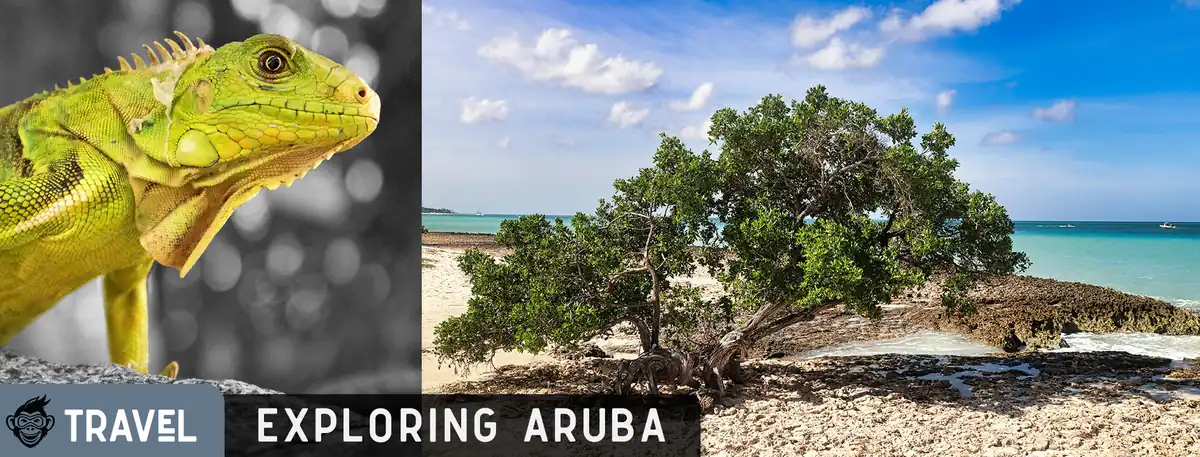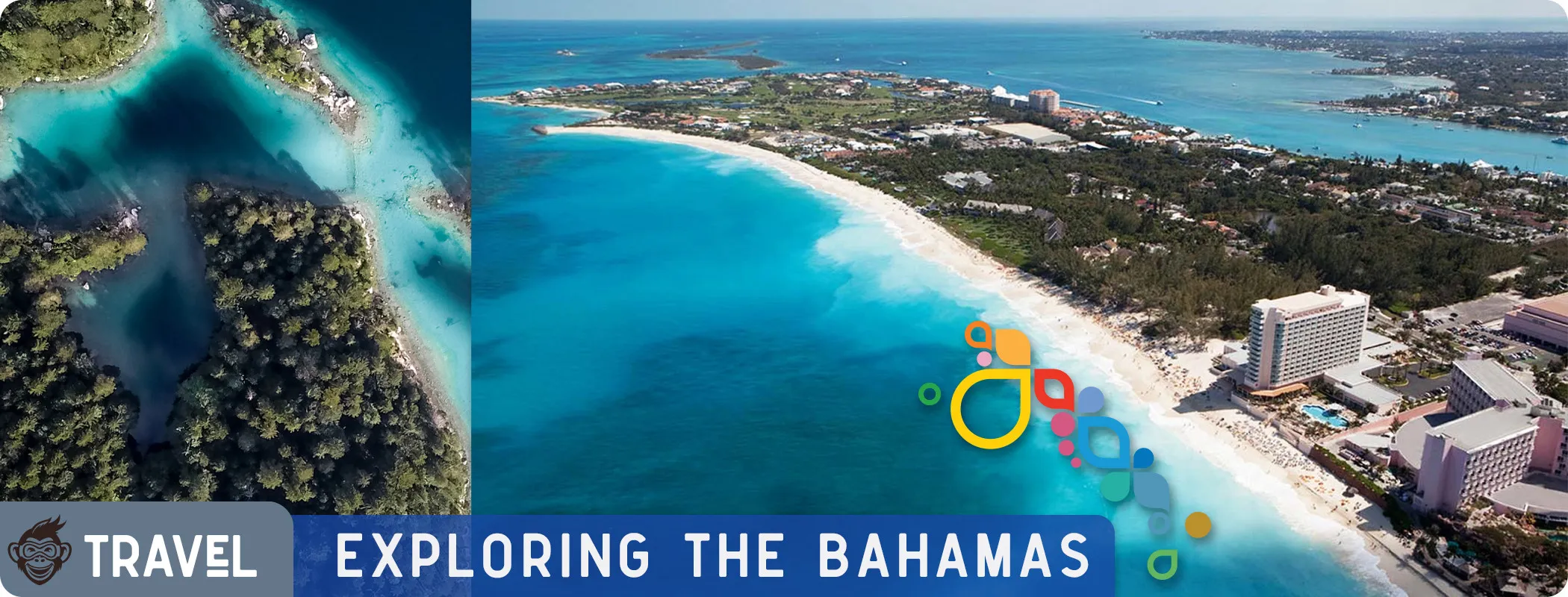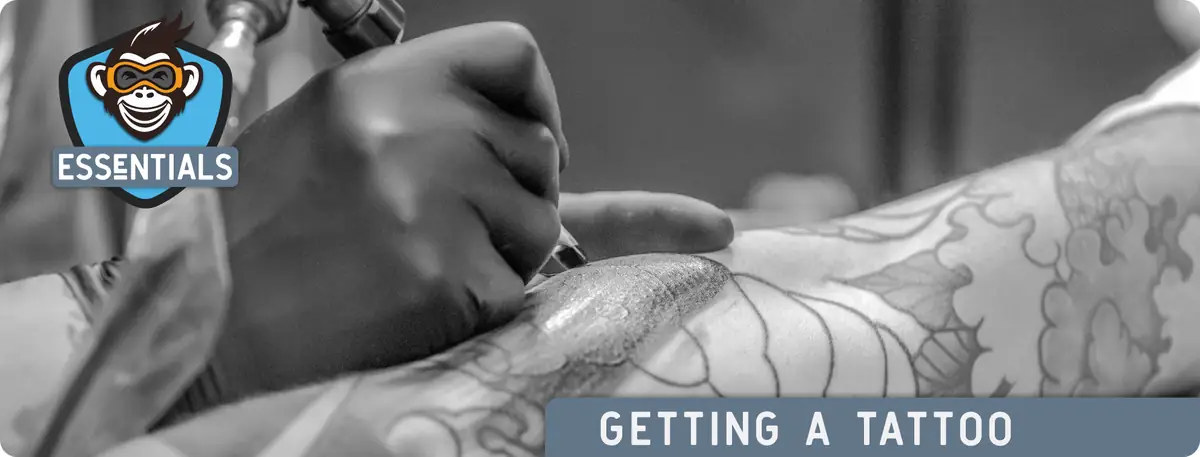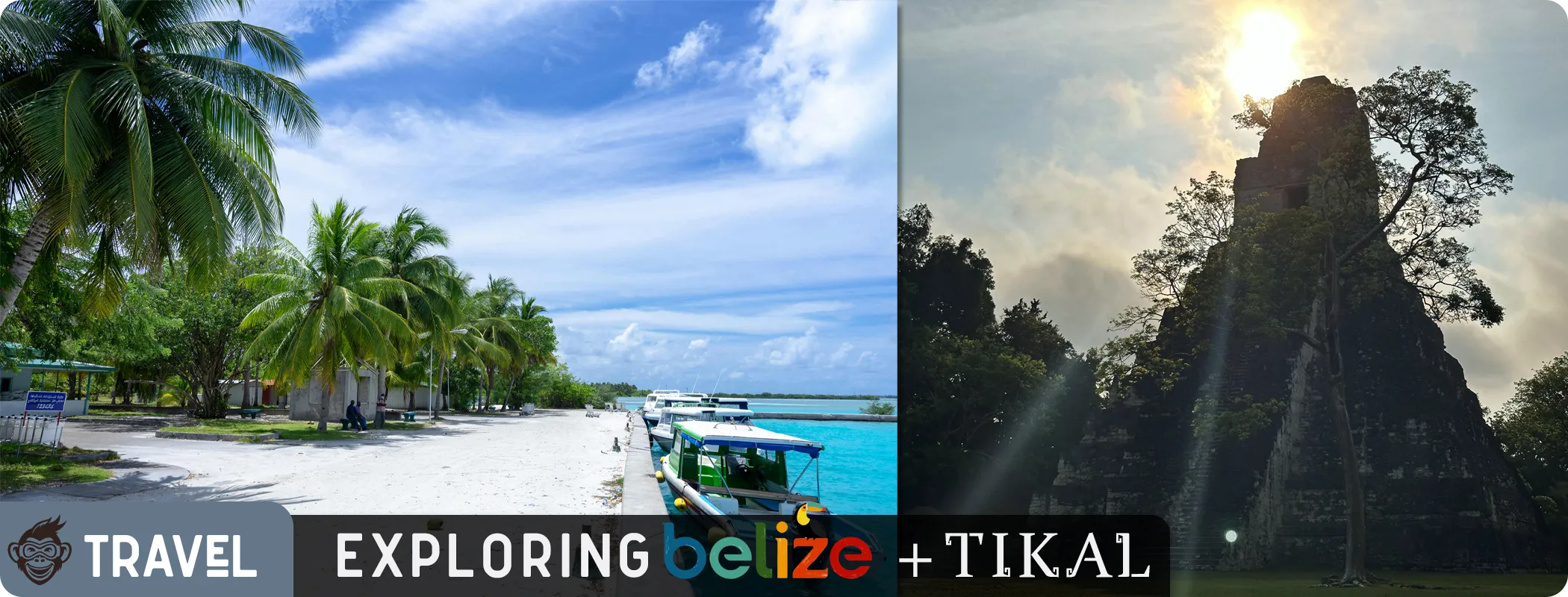
Exploring Aruba | Divi Village
Discover Aruba’s perfect Caribbean escape. From snorkeling with sea turtles to exploring flamingo islands, our stay at Divi Village Golf Resort put us at the heart of the One Happy Island’s adventures.
A Week at Divi Village Golf and Beach Resort
Aruba absolutely earned its "One Happy Island" nickname, and you can feel that welcoming spirit the moment you arrive at Divi Village Golf and Beach Resort. Sitting right on the island's western coast, where trade winds keep things comfortable year-round, this resort nails the balance between all-inclusive convenience and the freedom to explore. Our week here was a great balance of mixing relaxation with adventure - from morning tee times alongside wild burros to sunset sails on impossibly blue water.

The Accommodations
After checking in, a golf cart shuttle zipped us to our room, which was way bigger than we expected. Our villa had a king bed, two bathrooms, and a wide-open floor plan connecting the bedroom, living area, and a full kitchen. The in-unit washer and dryer were a lifesaver on a week-long trip, and we loved the private patio overlooking the infinity pool. Within an hour, we’d met our first iguana - one of thousands that call the island home. These prehistoric-looking critters are so common they're protected by law, and they've gotten surprisingly comfortable hanging out with people.
The layout gave us a rare vacation luxury: space. We stocked the fridge with local snacks, used the coffee maker for early mornings, and felt like we were living on the island rather than just passing through. That mindset shift changes how you notice a place.
Beach and Pools

The resort sits right on Divi Beach, where the Caribbean's signature turquoise water meets powder-soft sand. Because Aruba is safely tucked outside the hurricane belt, its beaches have consistently calm, clear water perfect for a swim. The temperature hangs around a perfect 80°F (27°C) all year, and the gentle slope into the water is great for everyone, whether you're just wading in or going for a serious swim.
Multiple pools across the property meant we could switch up the scenery. The infinity pool quickly became our favorite afternoon spot, thanks in large part to Enrique's masterful cocktail skills (check out the video below to see him in action). He turned drink-making into an art form - each one was perfectly balanced, beautifully presented, and mixed with genuine joy. Plus, the all-inclusive access extends to other Divi properties on the island, so our pool-hopping options felt endless. We’d pick a spot based on our mood: the lively main bar, a quieter adult pool, or the beach when we just wanted to hear the waves.
The constant trade winds help keep the heat from feeling overwhelming even at midday, which is one reason the Caquetío Arawak called the island “well-situated.” You’ll feel it the second you step outside.
Staying Active
The fitness center overlooking Divi Beach gives you the kind of motivation most hotel gyms can only dream of. Floor-to-ceiling windows mean you're staring at the ocean from the treadmill, and there’s even an outdoor climbing wall if you’re feeling adventurous. The gym is fully stocked with free weights, machines, and everything else you’d need - which is pretty important when you're up against the temptation of unlimited food and drinks.
Morning workouts became our go-to routine before the day got too hot. Hitting the gym at sunrise meant we got unobstructed ocean views and pleasant temps. Let's be honest: between Enrique's cocktails and the fantastic restaurants, that fitness center felt less like an option and more like a necessity.
Dining Experiences
The food at Divi was all about quality over quantity, with each restaurant offering its own unique vibe. Seabreeze Marketplace was our morning anchor, serving a breakfast buffet with everything from international favorites to Caribbean specialties. We loved the made-to-order omelet station, and the fresh tropical fruits and Dutch cheeses were a great nod to Aruba's history under the Netherlands.
Mulligans served up lunch and dinner in a laid-back golf-club setting. Their ceviche was incredibly fresh, and I'm pretty sure I ordered the filet mignon almost every day. And Windows on Aruba elevated the resort's culinary profile significantly. Panoramic views across the property complemented a more upscale preparation and attentive service. Yahaira led a team that balanced professionalism with warmth, sharing island stories between courses. The rack of lamb was cooked perfectly, while the veal chop's portion size impressed even before the first bite. And based on the recommendation of our server, we tried a Carajillo cocktail. Definitely check that one out if you're a fan of coffee.
One evening, we wandered over to the adjacent Divi All-Inclusive Resort and found ourselves in the middle of some wild entertainment - a dance competition that somehow pulled me from the crowd. My prize was a t-shirt that fit terribly (again - see the video), but the moment captured the spontaneous fun that makes Caribbean vacations so unforgettable.
Exploring the Island

Aruba is only about 20 miles long and 6 miles wide, which makes it surprisingly easy to explore with a rental car. We chose Sunset Rentals, a local company offering great rates, easy airport transfers, and vehicles suited to the island's varied terrain. Going local was the right move - we got insider tips, paid less than the big chains were charging, and had the peace of mind that the owners genuinely cared about our experience.
Arikok National Park occupies nearly 20% of Aruba's land mass, protecting diverse ecosystems from desert landscapes to coastal caves. Our guide Rambo shared the island's history while leading us through limestone caves carved by ancient seas. The park's diorite formations create dramatic contrast against white sand beaches, while endemic species like the Aruban burrowing owl make their home among the cacti and divi-divi trees that bend permanently eastward from constant trade winds.
The Natural Bridge area showcases the ocean's sculptural power. While the iconic large bridge collapsed in 2005 after thousands of years standing, the smaller bridge remains intact - a testament to limestone's gradual surrender to wave action. Nearby, the Bushiribana Gold Mill Ruins tell the story of Aruba's 1824 gold discovery. Over the next 90 years, mining operations extracted approximately 3 million pounds of gold before the industry collapsed. The fortress-like stone structure now stands as a photogenic reminder of that boom period.
The Aruba Ostrich Farm operates as one of the Caribbean's only ostrich breeding facilities. These birds - the world's largest - can weigh up to 350 pounds and sprint at 45 mph. Despite their intimidating size and dinosaur-like appearance, the farm's birds accept hand-feeding with remarkable gentleness. The facility also houses emus, peacocks, and various exotic birds, creating an unexpected wildlife experience on an island better known for beaches.
Casibari Rock Formations present a geological mystery. Scientists haven't definitively explained how these massive diorite boulders formed in the island's center, though volcanic origin remains the leading theory. Indigenous Arawak people considered the site sacred, carving petroglyphs that remain visible today. Climbing to the summit requires navigating a few narrow passages, but the 360-degree island views reward the effort.
The Aruba Donkey Sanctuary preserves a poignant piece of island history. The Spanish introduced donkeys around 1500 as primary transportation. At their peak, over 1,400 donkeys served the island's needs. Automobiles rendered them obsolete by the mid-20th century, and by 1970, disease and accidents had reduced the population to just 20 animals. The sanctuary formed in 1997 now cares for over 130 rescued donkeys, providing medical care, food, and permanent homes. Each receives a name and individual attention - compensation for centuries of service. Visitors can feed and interact with these gentle creatures, and donations help sustain operations.
Alto Vista Chapel, Aruba's oldest religious structure, dates to 1750 when Spanish missionary Domingo Antonio Silvestre built the original building to serve the island's small Catholic population. The current bright yellow structure - rebuilt in 1952 - sits atop a hill with sweeping ocean views. The peaceful setting contrasts sharply with the California Lighthouse nearby, named not for the U.S. state but for the British steamship "California" that wrecked off Aruba's northern coast in 1891 before the lighthouse existed to prevent such disasters.
In the south, the town of San Nicolaas tells an amazing story of rebirth. After its oil refinery closed in 2009, the town was facing economic collapse. Tito Bolivar traveled to Colombia, saw how street art was transforming cities there, and brought that idea home. The first Aruba Art Fair in 2016 attracted international muralists who transformed building facades into massive artworks. Today, with over 50 murals, San Nicolaas is buzzing with new life, proving that creativity can save a community.
While in San Nicolaas, we ate at O'Niel Caribbean Kitchen, and it was the real deal. The goat stew was incredible - slow-cooked, richly spiced, and a world away from the typical tourist fare. This is where you go to taste authentic island cooking.
The Aruba Aloe Farm traces its roots to 1840 when aloe vera arrived on the island. Aruba's arid climate and nutrient-rich soil proved ideal for cultivation, and by the early 1900s, two-thirds of the island grew aloe commercially. Royal Aruba Aloe, founded in 1890, ranks among the world's oldest aloe companies and served as the island's primary export for decades. The tour demonstrates the entire production process from harvesting through manufacturing, revealing why Aruba became synonymous with aloe products. One memorable lesson: the bright yellow sap between the leaf and gel acts as a powerful natural laxative - good to know before experimenting with raw plants!
The Sea Turtle Experience

I’ll be honest: open-ocean snorkeling is usually not my thing. Past attempts have left me feeling more awkward than amazed. Winston and his daughters at Sea Turtle Aruba completely changed that perspective. Their patient instruction, genuine passion for marine conservation, and careful attention to guest comfort transformed what I expected to tolerate into the highlight of our trip.
Aruba's waters are home to green and hawksbill sea turtles. Swimming alongside these ancient, graceful creatures as they navigated the reefs was a truly humbling experience. We also saw huge southern stingrays gliding by and schools of colorful tropical fish everywhere we looked. Winston's family picked us up from our hotel, provided all the gear, and made sure everyone felt safe and confident before getting in the water. That personal touch made all the difference.
Another person on our tour called it "115% worth every penny," and that pretty much summed it up. If you only have time for one excursion in Aruba, make it this one. It's an experience that will stick with you long after you've washed the salt from your hair.
Renaissance Island and the Flamingos
Few things define Aruba's Instagram era more than Renaissance Island flamingos. To get there, you either need to be a guest at the Renaissance Resort or snag a day pass. A quick boat ride (every 15 minutes) whisks you away to the 40-acre private island.
These Caribbean flamingos aren't actually native to Aruba; they were brought here about 15 years ago. The handful of resident birds wander freely between the adults-only Flamingo Beach and the family-friendly Iguana Beach. They're used to people, and staff makes sure no one harasses the birds. While the photos that went viral in 2017 put this place on the map, the island is more than just a photo op - with palm trees, hammocks, and clear water for snorkeling, it's a legitimate slice of paradise.
Even with its popularity, the island feels beautiful and natural. Get there early to enjoy the unique experience of sharing a beach with these iconic pink birds.
Hitting the Links

Divi Links is probably the only golf course in the Caribbean where wild burros and burrowing owls are part of the scenery. And they aren't just for show - they're actual wildlife sharing the fairways with you. The course itself is beautiful, designed to work with Aruba's natural landscape.
All-inclusive packages include one daily tee time, encouraging resort guests to experience the course multiple times during their stay. The layout works with rather than against the terrain, incorporating native vegetation, natural obstacles, and those ever-present trade winds. Golf skill level matters less than adapting to conditions - the wind adds unpredictability that challenges experienced players while providing convenient excuses for wayward shots. My ball found water hazards with remarkable consistency, but the course's beauty made even frustrating rounds enjoyable.
A quick tip: those same winds that mess with your chipping also keep you cool. Book an early morning tee time to avoid the midday Caribbean heat.
Sunset Sailing
The folks at Delphi Watersports began operations in 1992 when the family business rented aqua scooters from the beach. Their first boat arrived in 1994, adding sunset cruises to the service menu. The consistent trade winds that challenged my golf game create ideal sailing conditions, explaining why catamarans and sailboats dominate Aruba's tourism fleet.
The formula for a great sunset cruise is simple: open bar, snacks, a chance to swim, and a front-row seat to watch the sun dip below the horizon. Since Aruba is so close to the equator, sunset is reliably between 6:30 and 7:30 PM all year long. And with nearly 300 days of sunshine annually, a cloudy evening is pretty rare.
Watching the sky transition through color stages while gently rocking on Caribbean water provides a fitting daily conclusion. Sunsets are classic, but sometimes the classics work because they're fundamentally right.
Final Night Dining
Our final dinner at Pureocean Beachside Dining wrapped the week perfectly. This newer spot serves incredible food with your toes right in the sand - it’s the ultimate Caribbean dining experience. We started with fresh crab cakes, followed by a perfectly cooked filet and lobster. The service was fantastic, too - attentive but never intrusive.
The sunset happened right in the middle of our meal, turning dinner into a full sensory experience. The clear sky, warm breeze, and amazing food created one of those moments that makes all the travel planning completely worth it. It was the ideal final impression of an island that had wowed us all week long.

Divi Village Golf and Beach Resort was the perfect home base for our Aruban adventure. The resort itself is fantastic, with great rooms, food, and a staff that genuinely wants you to have a good time. But its real value is that it puts the entire island within your reach.
Aruba's small size means you can see and do a lot in just one week. From the desert landscapes of Arikok National Park to the vibrant street art of San Nicolaas, the island is packed with diversity. Renting a car from Sunset gave us the freedom to explore, while booking the sea turtle tour with Winston's family gave us the week's best memory.
The "One Happy Island" nickname isn't just clever marketing - it's real. The trade winds keep you cool, the location keeps the weather reliable, and the beaches are postcard-perfect. Divi Village let us enjoy all of it in comfort and style.
Aruba manages to be both accessible and authentic. It's easy enough for a relaxing vacation but has enough depth to reward anyone with a bit of curiosity. It’s that perfect blend of chilling out and heading out that makes a trip here so special. Want to see it for yourself? Check out our video below to bring the week to life.
A Video of Our Aruba Experience
About the Author

Ray is the founder of Stray Monkey, and as a shameless plug he wants to remind you to check out the SetScribe sports card collection app.
Share This Article
 Check These Out
Check These Out
Content not available. Please disable site blocker to view.
About Stray Monkey
Stray Monkey is your source for entertainment, travel, and lifestyle content that's a little off the beaten path.
Learn more about us







